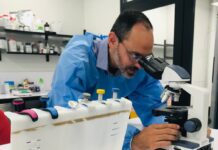
Scientists at UNSW Sydney have engineered protein filaments capable of producing electricity from ambient moisture, opening avenues for sustainable electronics.
In a recent study published in the journal Small, researchers unveiled that protein nanowires, engineered with a single compound addition, exhibit the ability to conduct electricity over short distances and tap into energy from atmospheric moisture.
Lead author Dr Lorenzo Travaglini emphasised the significance of these findings, stating, “Our findings open up possibilities for developing sustainable and environmentally friendly electrical components and devices, based on proteins.”
This interdisciplinary initiative, combining protein engineering and nanoelectronics, stands poised to revolutionise technology, bridging biological systems with electronic devices, the university said in a news release.
Dr Travaglini, supervised by Dr Dominic Glover in the SYNbioLAB at the School of Biotechnology and Biomolecular Sciences, said he envisions a future where materials derived from bacteria could underpin electronic components, ushering in an era of sustainable electronics.
Drawing inspiration from natural processes, the team said they harnessed the movement of electrons, such as those observed in photosynthesis, for novel electricity harvesting techniques.
Bacteria naturally employ conductive filaments, termed nanowires, to transfer electrons, suggesting potential applications in biosensing.
However, extracting and modifying these natural nanowires pose challenges. To overcome these limitations, the team genetically engineered protein fibres using E. coli bacteria, incorporating a critical component: haem molecules.
Haem molecules, arranged closely together, facilitate electron transfer. Integration of haem into bacterial filaments rendered them conductive, with the ability to harness humidity for energy generation.
The team said they observed enhanced conductivity in ambient conditions with moderate humidity levels.
“We started to notice that under what is considered ‘ambient conditions’, between 20 – 30 per cent humidity, the electric current was stronger,” Dr Travaglini stated.
Leveraging this property, they developed a simple humidity sensor, demonstrating the filament’s responsiveness to environmental moisture.
Dr Travaglini underscored the potential of this research in producing eco-friendly electrical devices, contrasting conventional electronics, which often rely on energy-intensive processes and toxic materials.
“The electronics we tend to use are created through processes that require high temperatures and are very energy-demanding. They’re not green, and the materials they are sourced from can be toxic,” said Dr Travaglini.
The team said they are exploring avenues to further enhance the properties of these protein assemblies, including experimentation with different porphyrin molecules.
While acknowledging the early stage of their research, Dr Travaglini said he remains optimistic about the future applications of engineered filaments in everyday electronics.
He emphasised the importance of continued translation efforts to realise the full potential of this groundbreaking technology.
“We don’t know how long exactly it’s going to take, but we can see that we are going in the right direction,” he concluded.














